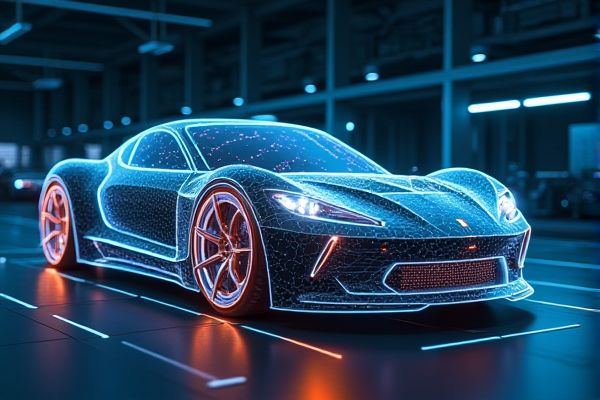
AI significantly enhances design processes in automotive engineering, enabling rapid prototyping and simulation that reduce development time. Machine learning algorithms analyze vast amounts of data from vehicle performance to identify patterns, improving safety and efficiency. Predictive maintenance powered by AI helps anticipate mechanical failures, minimizing downtime and increasing reliability. Advanced driver-assistance systems (ADAS) incorporate AI to improve decision-making in real-time, leading to safer driving experiences.
AI usage in automotive engineering
Autonomous driving systems
AI technology in automotive engineering enhances the development of autonomous driving systems. For instance, companies like Tesla use machine learning algorithms to improve vehicle navigation and safety. The integration of AI can potentially reduce human error and increase efficiency in traffic management. This advancement presents the possibility of transforming urban mobility and offering more sustainable transportation solutions.
Predictive maintenance
AI enhances predictive maintenance in automotive engineering by analyzing data from vehicle sensors to forecast potential failures. Companies like Ford utilize AI algorithms to improve vehicle reliability and reduce downtime. This approach allows for timely interventions, ultimately saving costs associated with unscheduled repairs. The integration of machine learning models increases the accuracy of maintenance schedules based on real-time performance data.
Smart navigation and route optimization
AI usage in automotive engineering can enhance smart navigation and route optimization. Companies like Tesla employ machine learning algorithms to analyze traffic patterns and improve travel efficiency. This technology can lead to reduced fuel consumption and shorter travel times for drivers. The integration of real-time data could also provide a chance for better safety and lower accident rates in urban areas.
Vehicle-to-everything (V2X) communication
AI integration in automotive engineering presents opportunities for enhancing Vehicle-to-Everything (V2X) communication. This technology could improve traffic management by allowing vehicles to share information about road conditions and potential hazards. Automakers, such as Ford, could leverage AI algorithms to analyze real-time data for better decision-making. The potential for reduced accidents and improved traffic flow represents significant advantages for urban planners and commuters alike.
Advanced driver-assistance systems (ADAS)
AI in automotive engineering enhances the functionality of Advanced Driver-Assistance Systems (ADAS) by improving real-time decision-making capabilities. The integration of AI algorithms allows vehicles to process data from sensors more efficiently, potentially reducing accident rates. Manufacturers like Tesla leverage these technologies to offer features such as automatic lane changes and adaptive cruise control. This advancement could lead to more reliable vehicle performance and foster increased consumer confidence in autonomous solutions.
AI-driven quality control and inspection
AI-driven quality control and inspection in automotive engineering has the potential to enhance production efficiency and reduce defects. Automated systems can analyze data from sensors and cameras to detect anomalies in real-time, allowing for quicker adjustments during manufacturing. Companies like Tesla are already leveraging AI to streamline their processes and ensure higher standards of quality. This technology increases the chance of achieving consistent output and can lead to significant cost savings over time.
Energy-efficient powertrain design
AI in automotive engineering offers the potential for optimizing energy-efficient powertrain design. By analyzing vast datasets, AI can suggest improvements that enhance fuel efficiency and reduce emissions. For example, institutions like MIT have explored machine learning models that predict performance outcomes based on various design parameters. This application can lead to advancements in sustainability and cost savings within the industry.
In-cabin experience and personalization
AI can enhance in-cabin experiences by analyzing driver and passenger preferences to tailor settings for comfort and entertainment. For instance, companies like Tesla leverage AI to personalize navigation and media options based on individual usage patterns. Predictive maintenance powered by AI can also optimize vehicle performance and reliability, potentially reducing costs for consumers. The integration of voice recognition technology further facilitates a more intuitive user interaction, creating a more enjoyable driving experience.
Production and supply chain optimization
AI has the potential to significantly enhance automotive engineering by improving design processes and predictive maintenance. In production, AI algorithms can streamline assembly line operations, reducing downtime and increasing efficiency. Supply chain optimization can benefit from AI's ability to analyze data, forecast demand, and manage inventory levels effectively, leading to cost savings. For example, companies like Tesla leverage AI to optimize their production flows and enhance vehicle performance.
Crash simulation and safety analysis
AI can enhance crash simulation and safety analysis in automotive engineering by increasing the accuracy of predictive models. For instance, using AI algorithms can optimize the design of vehicle components, improving their performance during collisions. This technology can potentially reduce the time and cost associated with traditional testing methods. Companies like Tesla are already exploring these advancements to improve vehicle safety and design efficiency.
 techknowy.com
techknowy.com